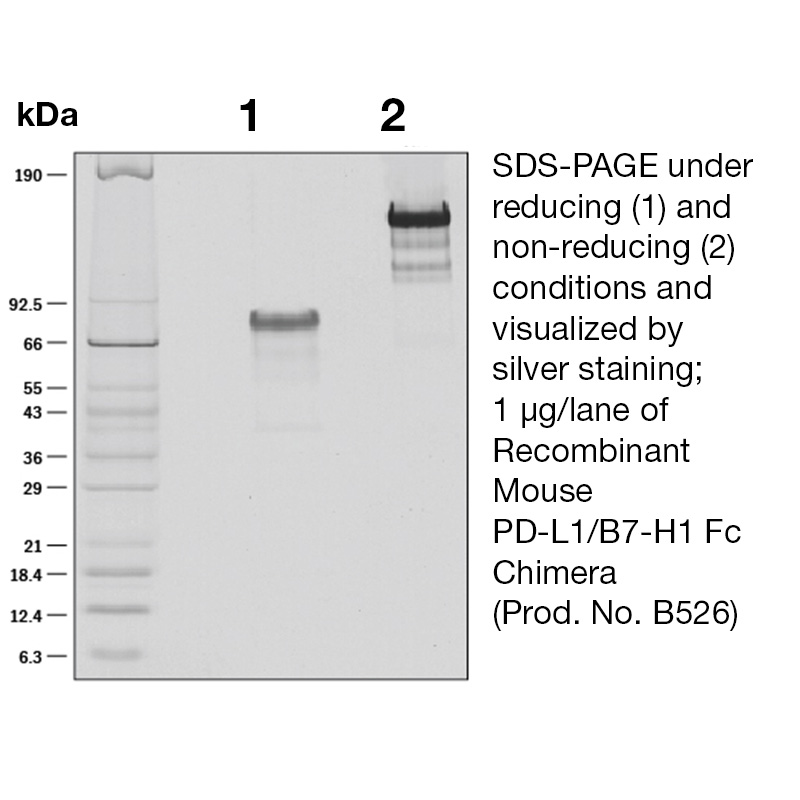Recombinant Mouse PD-L1 (B7-H1)
Data
- -
- -
BackgroundPD-1 is a 50-55 kD member of the B7 Ig superfamily. PD-1 is also a member of the extended CD28/CTLA-4 family of T cell regulators and is suspected to play a role in lymphocyte clonal selection and peripheral tolerance. The ligands of PD-1 are PD-L1 and PD-L2, and are also members of the B7 Ig superfamily. PD-1 and its ligands negatively regulate immune responses. PD-L1, or B7-Homolog 1, is a 40 kD type I transmembrane protein that has been reported to costimulate T cell growth and cytokine production. The interaction of PD-1 with its ligand PD-L1 is critical in the inhibition of T cell responses that include T cell proliferation and cytokine production. PD-L1 has increased expression in several cancers. Inhibition of the interaction between PD-1 and PD-L1 can serve as an immune checkpoint blockade by improving T-cell responses In vitro and mediating preclinical antitumor activity. Within the field of checkpoint inhibition, combination therapy using anti-PD1 in conjunction with anti-CTLA4 has significant therapeutic potential for tumor treatments. PD-L2 is a 25 kD type I transmembrane ligand of PD-1. Via PD-1, PD-L2 can serve as a coinhibitor of T cell functions. Regulation of T cell responses, including enhanced T cell proliferation and cytokine production, can result from mAbs that block the PD-L2 and PD-1 interaction. Protein DetailsPurity >90% by SDS-PAGE and analyzed by silver stain. Endotoxin Level <0.1 EU/µg as determined by the LAL method Biological Activity The biological activity of Mouse B7-H1 was determined by its ability to inhibit anti-CD3 induced proliferation of 72 hour PHA T cell blast. The expected ED<sub>50</sub> for this effect is typically 2.5 - 10 μg/mL. Fusion Protein Tag Fc Fusion Protein Protein Accession No. Amino Acid Sequence ft itapkdlyvv eygsnvtmec rfpvereldl lalvvyweke deqviqfvag eedlkpqhsn frgraslpkd qllkgnaalq itdvklqdag vycciisygg adykritlkv napyrkinqr isvdpatseh elicqaegyp eaeviwtnsd hqpvsgkrsv ttsrtegmll nvtsslrvna tandvfyctf wrsqpgqnht aeliipelpa thppqnrtie grmdpkscdk thtcppcpap ellggpsvfl fppkpkdtlm isrtpevtcv vvdvshedpe vkfnwyvdgv evhnaktkpr eeqynstyrv vsvltvlhqd wlngkeykck vsnkalpapi ektiskakgq prepqvytlp psrdeltknq vsltclvkgf ypsdiavewe sngqpennyk ttppvldsdg sfflyskltv dksrwqqgnv fscsvmheal hnhytqksls lspgk N-terminal Sequence Analysis Phe19 State of Matter Lyophilized Predicted Molecular Mass The predicted molecular weight of Recombinant Mouse B7-H1 is Mr 51.3 kDa. However, the actual molecular weight as observed by migration on SDS-PAGE is Mr 75-85 kDa. Predicted Molecular Mass 51.3 Formulation This recombinant protein was 0.2 µm filtered and lyophilized from modified Dulbecco’s phosphate buffered saline (1X PBS) pH 7.2 – 7.4 with no calcium, magnesium, or preservatives. Storage and Stability This lyophilized protein is stable for six to twelve months when stored desiccated at -20°C to -70°C. After aseptic reconstitution, this protein may be stored at 2°C to 8°C for one month or at -20°C to -70°C in a manual defrost freezer. Avoid Repeated Freeze Thaw Cycles. See Product Insert for exact lot specific storage instructions. Country of Origin USA Shipping Next Day Ambient NCBI Gene Bank References & Citations1. Sheppard, KA. et al. (2004) FEBS Letters 574:37 2. Flies, DB. et al. (2007) J. Immunol. 30:251 3. Yamazaki, T. et al. (2002) J. Immunol. 169:5538 4. Thompson, RH. et al. (2004) Proc. Natl. Acad. Sci. USA 101:17174 Certificate of AnalysisIMPORTANT Use lot specific datasheet for all technical information pertaining to this recombinant protein. |
Related Products
- -
- -
Prod No. | Description |
|---|---|
P370 | |
P369 | |
P368 | |
P363 | |
P371 | |
B557 | |
B526 | |
B605 | |
B530 |




